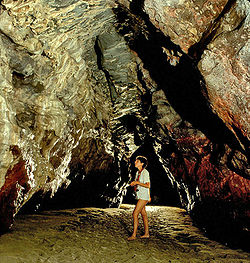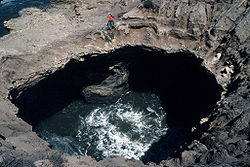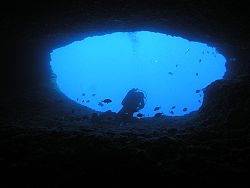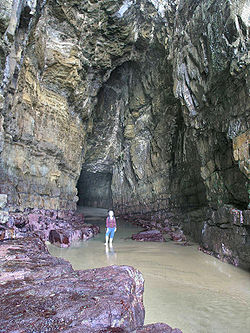
Sea caves
Encyclopedia

Cave
A cave or cavern is a natural underground space large enough for a human to enter. The term applies to natural cavities some part of which is in total darkness. The word cave also includes smaller spaces like rock shelters, sea caves, and grottos.Speleology is the science of exploration and study...
formed primarily by the wave
Wave
In physics, a wave is a disturbance that travels through space and time, accompanied by the transfer of energy.Waves travel and the wave motion transfers energy from one point to another, often with no permanent displacement of the particles of the medium—that is, with little or no associated mass...
action of the sea
Sea
A sea generally refers to a large body of salt water, but the term is used in other contexts as well. Most commonly, it means a large expanse of saline water connected with an ocean, and is commonly used as a synonym for ocean...
. The primary process involved is erosion. Sea caves are found throughout the world, actively forming along present coastlines and as relict
Relict
A relict is a surviving remnant of a natural phenomenon.* In biology a relict is an organism that at an earlier time was abundant in a large area but now occurs at only one or a few small areas....
sea caves on former coastlines. Some of the largest wave-cut caves in the world are found on the coast of Norway, but are now 100 feet or more above present sea level. These would still be classified as littoral caves. By contrast, in places like Thailand's Phang Nga Bay
Phang Nga Bay
Phang Nga Bay is a 400 km² bay in the Andaman Sea between the island of Phuket and the mainland of the Malay peninsula of southern Thailand. Since 1981, an extensive section of the bay has been protected as the Ao Phang Nga National Park...
, solutionally formed caves in limestone have been flooded by the rising sea and are now subject to littoral erosion, representing a new phase of their enlargement.
Some of the best-known sea caves are European. Fingal's Cave
Fingal's Cave
Fingal's Cave is a sea cave on the uninhabited island of Staffa, in the Inner Hebrides of Scotland, part of a National Nature Reserve owned by the National Trust for Scotland. It is formed entirely from hexagonally jointed basalt columns, similar in structure to the Giant's Causeway in Northern...
, on the Scottish island of Staffa
Staffa
Staffa from the Old Norse for stave or pillar island, is an island of the Inner Hebrides in Argyll and Bute, Scotland. The Vikings gave it this name as its columnar basalt reminded them of their houses, which were built from vertically placed tree-logs....
, is a spacious cave some 70 m long, formed in columnar basalt. The Blue Grotto of Capri
Capri
Capri is an Italian island in the Tyrrhenian Sea off the Sorrentine Peninsula, on the south side of the Gulf of Naples, in the Campania region of Southern Italy...
, although smaller, is famous for the apparent luminescent quality of its water, imparted by light passing through openings underwater. The Romans built a stairway in its rear and a now-collapsed tunnel to the surface. The Greek islands are also noted for the variety and beauty of their sea caves. Numerous sea caves have been surveyed in England, Scotland, and in France, particularly on the Normandy coast. The largest sea caves are found along the west coast of the United States, the Hawaiian islands, and the Shetland Islands.
Formation




Metamorphic rock
Metamorphic rock is the transformation of an existing rock type, the protolith, in a process called metamorphism, which means "change in form". The protolith is subjected to heat and pressure causing profound physical and/or chemical change...
to igneous, but caves in the latter tend to be larger due to the greater strength of the host rock.
In order to form a sea cave, the host rock must first contain a weak zone. In metamorphic or igneous rock, this is typically either a fault as in the caves of the Channel Islands of California
Channel Islands of California
The Channel Islands of California are a chain of eight islands located in the Pacific Ocean off the coast of Southern California along the Santa Barbara Channel in the United States of America...
, or a dike
Dike (geology)
A dike or dyke in geology is a type of sheet intrusion referring to any geologic body that cuts discordantly across* planar wall rock structures, such as bedding or foliation...
as in the large sea caves of Kauai
Kauai
Kauai or Kauai, known as Tauai in the ancient Kaua'i dialect, is geologically the oldest of the main Hawaiian Islands. With an area of , it is the fourth largest of the main islands in the Hawaiian archipelago, and the 21st largest island in the United States. Known also as the "Garden Isle",...
, Hawaii
Hawaii
Hawaii is the newest of the 50 U.S. states , and is the only U.S. state made up entirely of islands. It is the northernmost island group in Polynesia, occupying most of an archipelago in the central Pacific Ocean, southwest of the continental United States, southeast of Japan, and northeast of...
’s Na Pali Coast. In sedimentary rocks, this may be a bedding-plane parting or a contact between layers of different hardness. The latter may also occur in igneous rocks, such as in the caves on Santa Cruz Island
Santa Cruz Island
Santa Cruz Island was the largest privately owned island off the continental United States, but is currently part-owned by the National Park service . The island, located off the coast of California, is long and from wide...
, California
California
California is a state located on the West Coast of the United States. It is by far the most populous U.S. state, and the third-largest by land area...
, where waves have attacked the contact between the andesitic basalt
Basalt
Basalt is a common extrusive volcanic rock. It is usually grey to black and fine-grained due to rapid cooling of lava at the surface of a planet. It may be porphyritic containing larger crystals in a fine matrix, or vesicular, or frothy scoria. Unweathered basalt is black or grey...
and the agglomerate
Agglomerate
Agglomerates are coarse accumulations of large blocks of volcanic material that contain at least 75% bombs...
.
The driving force in littoral cave development is wave action. Erosion is ongoing anywhere that waves batter rocky coasts, but where sea cliffs contain zones of weakness, rock is removed at a greater rate along these zones. As the sea reaches into the fissures thus formed, they begin to widen and deepen due to the tremendous force exerted within a confined space, not only by direct action of the surf and any rock particles that it bears, but also by compression of air within. Blowhole
Blowhole (geology)
In geology, a blowhole is formed as sea caves grow landwards and upwards into vertical shafts and expose themselves towards the surface, which can result in blasts of water from the top of the blowhole if the geometry of the cave and blowhole and state of the weather are appropriate.A blowhole is...
s (partially submerged caves that eject large sprays of sea water as waves retreat and allow rapid re-expansion of air compressed within) attest to this process. Adding to the hydraulic power of the waves is the abrasive force of suspended sand and rock. Most sea-cave walls are irregular and chunky, reflecting an erosional process where the rock is fractured piece by piece. However, some caves have portions where the walls are rounded and smoothed, typically floored with cobbles, and result from the swirling motion of these cobbles in the surf zone.
True littoral caves should not be confused with inland caves that have been intersected and revealed when a sea cliff line is eroded back, or with dissolutional voids formed in the littoral zone on tropical islands. In some regions, such as Halong Bay
Halong Bay
Ha Long Bay is a UNESCO World Heritage Site, and a popular travel destination, located in Quang Ninh province, Vietnam. Administratively, the bay belongs to Hạ Long City, Cẩm Phả town, and part of Van Don district. The bay features thousands of limestone karsts and isles in various sizes and shapes...
, Vietnam
Vietnam
Vietnam – sometimes spelled Viet Nam , officially the Socialist Republic of Vietnam – is the easternmost country on the Indochina Peninsula in Southeast Asia. It is bordered by China to the north, Laos to the northwest, Cambodia to the southwest, and the South China Sea –...
, caves in carbonate rocks are found in littoral zones but were formed by dissolution.
Rainwater may also influence sea-cave formation. Carbonic and organic acids leached from the soil may assist in weakening rock within fissures. As in solutional caves, small speleothems may develop in sea caves.
Sea cave chambers sometimes collapse leaving a “littoral sinkhole”. These may be quite large, such as Oregon
Oregon
Oregon is a state in the Pacific Northwest region of the United States. It is located on the Pacific coast, with Washington to the north, California to the south, Nevada on the southeast and Idaho to the east. The Columbia and Snake rivers delineate much of Oregon's northern and eastern...
’s Devil’s Punchbowl or the Queen’s Bath on the Na Pali coast. Small peninsulas or headlands often have caves that cut completely through them, since they are subject to attack from both sides, and the collapse of a sea cave tunnel can leave a free-standing “sea stack” along the coast. The Californian island of Anacapa
Anacapa Island
Anacapa Island is a small volcanic island located about off the coast of Port Hueneme, California, in Ventura County. The Island is composed of a series of narrow islets six miles long, running in a mostly east-west orientation, five miles east of Santa Cruz Island...
is thought to have been split into three islets by such a process.
Life within sea caves may assist in their enlargement as well. For example, sea urchins drill their way into the rock, and over successive generations may remove considerable bedrock from the floors and lower walls. You might not find a big variety of fishes.
Factors influencing size

Several factors contribute to the development of relatively large sea caves. The nature of the zone of weakness itself is surely a factor, although difficult to quantify. A more readily observed factor is the situation of the cave’s entrance relative to prevailing sea conditions. At Santa Cruz Island
Santa Cruz Island
Santa Cruz Island was the largest privately owned island off the continental United States, but is currently part-owned by the National Park service . The island, located off the coast of California, is long and from wide...
, the largest caves face into the prevailing northwest swell conditions—a factor which also makes them more difficult to survey. Caves in well-protected bays sheltered from prevailing seas and winds tend to be smaller, as are caves in areas where the seas tend to be calmer.
The type of host rock is important as well. All of the largest sea caves are in basalt
Basalt
Basalt is a common extrusive volcanic rock. It is usually grey to black and fine-grained due to rapid cooling of lava at the surface of a planet. It may be porphyritic containing larger crystals in a fine matrix, or vesicular, or frothy scoria. Unweathered basalt is black or grey...
, a strong host rock compared to sedimentary rock. Basaltic caves can penetrate far into cliffs where most of the surface erodes relatively slowly. In weaker rock, erosion along a weaker zone may not greatly outstrip that of the cliff face.
Time is another factor. The active littoral zone changes throughout geological time by an interplay between sea-level change and regional uplift. Recurrent ice ages during the Pleistocene
Pleistocene
The Pleistocene is the epoch from 2,588,000 to 11,700 years BP that spans the world's recent period of repeated glaciations. The name pleistocene is derived from the Greek and ....
have changed sea levels within a vertical range of some 200 meters. Significant sea caves have formed in the California Channel Islands that are now totally submerged by the rise in sea levels over the last 12 000 years. In regions of steady uplift, continual littoral erosion may produce sea caves of great height — Painted Cave is almost 40 m high at its entrance. On the Norwegian coast there are huge sea caves now uplifted 30 or more meters above sea level. Sediment dating in the largest of these (Halvikshulen in Osen, 340 m long)shows that it was formed over a period of at least a million years. It may well be the largest wave-cut cave known by both length and volume.
Finally, caves that are larger tend to be more complex. By far the majority of sea caves consist of a single passage or chamber. Those formed on faults tend to have canyon-like or angled passages that are very straight. In Seal Canyon Cave on Santa Cruz Island, entrance light is still visible from the back of the cave 189 m from the entrance. By contrast, caves formed along horizontal bedding planes tend to be wider with lower ceiling heights. In some areas, sea caves may have dry upper levels, lifted above the active littoral zone by regional uplift.
Sea caves can prove surprisingly complex where numerous zones of weakness—often faults—converge. In Catacombs Cave on Anacapa Island
Anacapa Island
Anacapa Island is a small volcanic island located about off the coast of Port Hueneme, California, in Ventura County. The Island is composed of a series of narrow islets six miles long, running in a mostly east-west orientation, five miles east of Santa Cruz Island...
(California), at least six faults intersect. In several caves of the Californian Channel Islands, long fissure passages open up into large chambers beyond. This is invariably associated with intersection of a second fault oriented almost perpendicularly to that along the entrance passage. When caves have multiple entrances, they are exposed to more wave action and hence may grow relatively faster. There is an exceptionally large cave underlying the Fogla Skerry, an islet off the coast of Papa Stour, in the Shetland Islands. Though unsurveyed, estimates place it at almost 500 m of passage--meaning it could actually be the world's longest sea cave.
External links
- Photos and information on sea caves in the Virtual Cave

